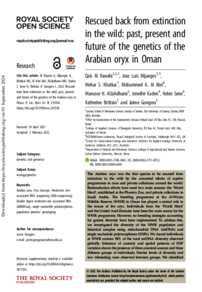Document
Rescued back from extinction in the wild : past, present and future of the genetics of the Arabian oryx in Oman.
Identifier
DOI: 10.1098/rsos.210558
Source
Royal Society Open Science. v. 9, 3, 20220035
Contributors
Mijangos, Jose Luis., Author
Khatkar, Mehar S., Author
Al-Abri, Mohammed A. , Author
Al-Jahdhami, Mansoor H., Author
Kaden, Jennifer., Author
Senn, Helen., Author
Brittain, Katherine., Author
Gongora, Jaime., Author
Country
United Kingdom.
Publisher
Royal Society Publishing.
Gregorian
2022-01-01
Language
English
Subject
English abstract
The Arabian oryx was the first species to be rescued from extinction in the wild by the concerted efforts of captive programmes in zoos and private collections around the world. Reintroduction efforts have used two main sources: the 'World Herd', established at the Phoenix Zoo, and private collections in Saudi Arabia. The breeding programme at the Al-Wusta Wildlife Reserve (WWR) in Oman has played a central role in the rescue of the oryx. Individuals from the 'World Herd' and the United Arab Emirates have been the main source for the WWR programme. However, no breeding strategies accounting for genetic diversity have been implemented. To address this, we investigated the diversity of the WWR population and historical samples using mitochondrial DNA (mtDNA) and single nucleotide polymorphisms (SNPs). We found individuals at WWR contain 58% of the total mtDNA diversity observed globally. Inference of ancestry and spatial patterns of SNP variation shows the presence of three ancestral sources and three different groups of individuals. Similar levels of diversity and low inbreeding were observed between groups. We identified individuals and groups that could most effectively contribute to maximizing genetic diversity. Our results will be valuable to guide breeding and reintroduction programmes at WWR.
ISSN
2054-5703
Category
Journal articles

